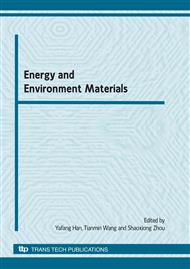p.109
p.115
p.119
p.126
p.132
p.137
p.142
p.150
p.157
Effects of Ag Addition on High Temperature Thermoelectric Properties of (Ca0.9Gd0.1)3Co4O9 Ceramics
Abstract:
A series of (Ca0.9Gd0.1)3Co4O9/xAg(x=0, 0.1, 0.15, 0.2) ceramics were prepared by a polyacrylamide gel method and Spark Plasma Sintering. Scanning electron microscopy (SEM) revealed that small size Ag particles were dispersed into the (Ca0.9Gd0.1)3Co4O9(CGCO) matrix. The electrical conductivity of the composites was obviously higher than that of (Ca0.9Gd0.1)3Co4O9, and increased with increase of Ag content. However, the addition of Ag seemed to have a negative impact on the Seebeck coefficient (S) of the composites samples due to its poor S. Since the increase of electrical conductivity (σ) is more significant than the degradation of S, the power factor (P=σS2) was found to be improved by the addition of Ag. At 973 K, the P value of the sample with x =0.2 reached 3.17×10-4 W•m-1•K-2, which was 12.5% higher than that of Ca3Co4O9(CCO) bulk material.
Info:
Periodical:
Pages:
132-136
Citation:
Online since:
May 2010
Authors:
Keywords:
Price:
Сopyright:
© 2010 Trans Tech Publications Ltd. All Rights Reserved
Share:
Citation:


